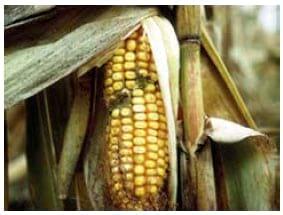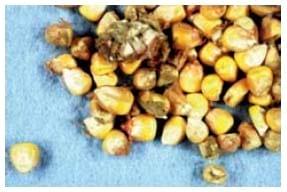Control of aflatoxin M1 in Milk
Aflatoxin M1 in Milk
Published: October 15, 2012
By: Jodie A. Pennington, Professor Dairy and Goats
Introduction
Aflatoxins are mycotoxins of major concern to the dairy industry. Most mycotoxins are found in grain, usually grown in a drought, although they may contaminate pasture grass and occasionally hay. Most frequently, aflatoxins are found in corn (see Figures 1-3) and cottonseed, and sometimes in their byproducts, but also on rare occasions in soybeans or distiller's grain. Peanut products also may be contaminated with aflatoxins and can result in aflatoxins in milk.
Figure 1.Aspergillus flavus in standing corn

Figure 2. Close-up of Aspergillus flavus on corn

Because aflatoxins are carcinogenic to animals and perhaps humans, they are monitored closely in the food supply. Aflatoxins are the most carcinogenic natural compounds known. Milk that is sold commercially is checked for aflatoxin M1. When aflatoxin M1 is found at concentrations of 0.5 parts per billion (ppb) or greater, the milk is discarded because it cannot be used for products that go into the human food supply. On occa- sion, milk pro cessors may also use a level less than the 0.5 parts per billion or 500 parts per trillion as a guideline for allowing milk into the human food supply.
Lactating cows that eat feed containing 20 ppb or greater aflatoxins may produce milk that exceeds the tolerance level for afla - toxins in milk. It usually takes the cow approximately two to three days on aflatoxin-free feed for milk concen- trations to fall below tolerance levels. The length of time required for milk to become aflatoxin free is dependent on the concentration of aflatoxins in the feed (and milk) as well as the diet being fed to the cow.
Figure 3. Aspergillus flavus in stored corn

Source of Aflatoxins in Milk
Aflatoxin M1 contamination of milk results primarily from the conversion of aflatoxin B1 that is metabolized by enzymes found primarily in the liver. After aflatoxin M1 is formed, it is excreted in the urine and milk of the cow. The action level for afla- toxin B1 is 20 parts per billion for feed fed to lactating dairy cows. As both aflatoxins B1 and M1 may cause cancer in humans, the action level of 0.5 parts per billion of aflatoxin M1 in milk is strictly enforced by the United States Food and Drug Administration (FDA).
Aflatoxin B1 in feed is a mycotoxin produced by Aspergillus molds that grow on grain, especially corn (Figures 1-3), cottonseed and sometimes peanuts. It is rarely found in forages and is usually not present in high enough concentrations in corn silage to be of concern. Feed does not contain aflatoxin M1 as it is found only in milk. Aflatoxins refer to a group of several chemicals produced by the Aspergillus flavus fungus and related species. The most common afla - toxins are B1, B2, G1, G2, M1 and M2. Aflatoxin M1 is the mycotoxin found in milk and is converted nor- mally from aflatoxin B1 in feed although other conversions may occur.
Once a level of contamination of 20 ppb in a feedstuff has been determined, the feed can no longer be used to feed milking dairy cattle. It also cannot be blended with other feeds to reduce the level of contamination, as the Food and Drug Administration does not allow this. However, young animals and breeding animals or dry dairy cows can be fed levels of feed with aflatoxin ranging up to 100 parts per billion. Feed that has aflatoxin levels of 100 to 200 ppb can be fed to finishing hogs and beef cattle. For levels of aflatoxin from 20 to 300 ppb, the use of the feed is limited to finishing beef cattle. When feed levels contain greater than 300 ppb, there are no legal feeding options for the grain. Grain with high levels of aflatoxin can be used for ethanol production. The resulting distiller's grain or maltage is likely to contain high concentrations of aflatoxin since aflatoxin is heat stable and, therefore, should not be fed to lactating dairy cows.
Blended grain products with high levels of aflatoxins can be used for direct feeding on the farm after they have been blended with other feeds. Federal law prohibits the sale of grain blended to reduce the aflatoxin levels. However, blending of the grain on the farm is the best option for using the grain with high levels of contamination of aflatoxins. The contaminated feed can be blended with clean grain or other products so that the level of contami- nation is diluted to an acceptable level. Blending is not recommended for corn or other products fed to lactating dairy cows because of the risk of pockets of contaminated feed. Instead, consider feeding the con - taminated grain to other animals such as heifers or beef cattle. As a general rule, aflatoxin-infected corn should be stored only for short periods of time as levels of contamination may increase in storage. When storing, it is critical to maintain low moisture levels (e.g., 13 to 15 percent if possible). Maintain the grain in storage at low temperatures, usually below 40 degrees F if weather permits.
Corn in the field that has been subjected to drought conditions is more susceptible to aflatoxin contamination. In cases of severe contamination, yellowish-green mold colonies will form on the ears and will fluoresce when exposed to a black light. Most elevators screen incoming corn and cottonseed products with a black light, which can identify poten- tial problems and aflatoxin contamination. However, less than half the samples of grain with contami - nation showed fluorescence under a black light in one study, although detectable levels of aflatoxin were present. Conversely, not all loads of grain that fluoresce will be positive for aflatoxins. Compounding the problem is that a load of grain rejected at one elevator as a result of a positive black light test may then be taken to another elevator where it will pass the test. If a load of grain fails the black light test initially, it should be sampled and sent to a laboratory for analysis. Samples containing only 5 contaminated kernels of corn per million kernels may be above the legal limit to feed to lactating dairy cows.
Reasons for failure to detect aflatoxin in grain with black light fluorescence may be related to the fact that Aspergillus metabolites may not show the same degree of fluorescence as the various aflatoxins. As a general rule, all loads of corn and cottonseed should be screened for aflatoxins and should not be fed to lactating dairy cows if fluorescence is seen. The grain can be fed to other animals as allowed by law.
An additional problem with aflatoxin is that it may be localized within specific parts of a load. This toxin is often located near the edges and corners of fields, where irrigation is poor. Sometimes, dairy producers unknowingly buy a small amount of contaminated grain. The grain is consumed by cows within one to two days and is detected in the milk two to three days later by the milk processor or marketing cooperative. Then, there is no remaining grain that shows high levels of aflatoxins.
Symptoms of Aflatoxicosis
Aflatoxicosis is the disease caused by the consumption of aflatoxins. For most producers, no visual symptoms of aflatoxicosis will be observed in the animals. However, high concentrations of afla - toxins and/or prolonged duration may cause visual symptoms in cattle, especially young calves. Beef and dairy cattle are more susceptible to aflatoxicosis than sheep and horses, although other mycotoxicoses occur in these species, such as facial eczema in sheep and leukoencephalomalacia in horses. Young animals of all species are more susceptible than mature animals to the effects of aflatoxin. Pregnant and growing animals are less susceptible than young animals, but more susceptible than mature animals.
Feed refusal, reduced growth rate and decreased feed efficiency are the predominant signs of chronic aflatoxin poisoning. In addition, listlessness, weight loss, rough hair coat and mild diarrhea may occur; anemia along with bruises and subcutaneous hemorrhages are also symptoms of aflatoxicosis. The disease may also impair reproductive efficiency, including abnormal estrous cycles (too short and too long) and abortions. Other symptoms include impaired immune system response, increased susceptibility to disease and rectal prolapse.
Clinical laboratory findings vary with the animal species, level of aflatoxin in the ration and the duration of feeding. There are no consistent diag - nostic changes in hematocrit, hemoglobin and differential cell counts in animals fed aflatoxin.
Leukocytosis may occur in animals with secondary bacterial infections. Serum bilirubin levels may be elevated, and typically serum protein levels are decreased.
Lesions observed at necropsy related to either acute or chronic liver disease are dependent upon the level of aflatoxin and the duration of feeding. A majority of acute liver damage observed has been the result of experimentally high doses, while chronic liver damage is a more common field observation. The liver is usually pale tan, yellow or orange. Hepatic fibrosis and edema of the gallbladder may also be observed.
The diagnosis of aflatoxicosis is often difficult because of the variation in clinical signs, gross pathological conditions and the presence of infectious diseases due to the suppression of the immune sys- tem. On the farm, more than one mold or toxin may be present in contaminated feed, which often makes definitive diagnosis of aflatoxicosis difficult.
The later effects of aflatoxicosis depend upon the severity of liver damage. Once overt symptoms are noticed, the prognosis is poor. Treatment should be directed at the severely affected animals in the herd and further poisoning prevented. Most lactating cows that show positive for aflatoxins in milk will not show visual symptoms.
What to Do if Milk Is Detected With Action Levels of Aflatoxin
If aflatoxin is detected in milk, it is critical that records be maintained of all feeds, feeding practices, milk quantities and contamination levels, plus animal health and performance. If the grain or related feed is fed to other animals, these records should be maintained also.
After milk has been detected with greater than 0.5 ppb of aflatoxin in one load, all grain products fed to animals should be removed from the ration immediately and new grain and/or related items replaced in the diet. As cottonseed and corn are the most likely sources of aflatoxin contamination, these grains should be tested to determine their level of aflatoxin. The exception to the preceding statement is when an additional milking has occurred on the dairy and the milk then tests below 0.5 ppb aflatoxin. In this case, the feed should be tested before it is removed from the feed supply.
It is illegal to sell grain with levels greater than 20 ppb aflatoxin for lactating dairy cows, and the seller of the grain is responsible for damage resulting from the sale of grain. However, in most cases, perhaps 60 percent of the time, the exact source of feed contamination is not deter- mined. In cases of severe contamination and over a prolonged period of time, some data indicate that animals may experience adverse health effects which can affect both present and long-term performance. Calves also are more susceptible to aflatoxin and have died as a result of aflatoxin contamination in feed.
Immediately after aflatoxin is detected in milk, the ration should be reformulated with ingredients that contain less than 20 ppb aflatoxin. If the level of milk contamination exceeds 0.5 ppb on a second test, a special dietary chemisorbent should be added to the diet at recommended levels. These compounds include clays (bentonites) at 1 percent of the diet, activated carbon at 1 percent of the diet and glucomannan (Mycosorb®) at 0.05 percent of the diet on a dry matter basis. Some empirical observations indicate that the animal may consume levels of bentonite up to one pound a day. Limited data is available on the numerous compounds that are available to absorb the aflatoxin in the digestive system. However, in one study, about 1/4 pound of hydrated sodium calcium aluminino silicate (HACA – a compound approved for feed as an anti-caking agent) was shown to reduce aflatoxin M1 in milk about 50 percent when cattle consumed feed containing 200 ppb aflatoxin. Silky clay loan soil and bentonite have a similar effect but have not been well studied. Many commercially avail- able products also theoretically will bind aflatoxin M1 and should result in lower aflatoxin in milk. Generally, the cost of using the commercially available products is greater than the cost of using bentonite to bind aflatoxin.
Tests to Detect Aflatoxin
Records should be maintained for all feeds, feeding practices, milk contamination and animal health and performance for all cases of aflatoxin contamination of milk. There are simple, fast, semi- quantitative tests which can be performed to test for aflatoxin. Kits using ELISA (enzyme-linked immunosorbent assay) technology are available to test on the farm as well as commercially. The cost per test on the farm is usually about $20 to $25 when prorating the cost of the incubator to conduct the test. Most laboratories will charge $30 to $75 per test for aflatoxin. An incubator to run the ELISA test will cost $200 to $400. The incubator also may be used to run tests for selected antibiotics in milk as well as aflatoxin.
To sample feed, take at least 8 to 12 samples at each of 3 to 5 locations in the feed bin or trough. Mix the sub-samples, and take a two-pound compos- ite sample. Divide the com posite sample into 2 one-pound samples. Store one sample in a cool, dry place, and use the other one for testing, either on the farm or at the laboratory. The second one-pound com- posite sample may be used for possible confirmatory testing or testing for other toxins.
Laboratories offer the ability to conduct basic mold counts, screen for specific molds and analyze for toxins. Testing capabilities and pricing will vary among labs. Some labs may not be recognized as accredited testing facilities, such as the Arkansas State Plant Board. In instances where possible litiga- tion will occur, results must come from an accredited lab. Always verify upon initial contact with a lab if it is an accredited testing facility. Below are known laboratories that offer these services in or near Arkansas; however, testing for aflatoxin is not limited to these facilities.
Additionally, test kits for aflatoxin are available commercially which do not require a reader, but these tests are primarily for feedstuffs. Although data indicate that the concentration of aflatoxin M1 in milk is equal to 1.51 percent of the concentration of aflatoxin B1 in the diet, there are many factors that affect the level of aflatoxin in milk.
Summary
Mycotoxin production is found most frequently in pre-harvest grains that are harvested under high temperatures, prolonged drought and high insect activity. Thus, aflatoxin contamination in grain is much greater in states such as Arkansas which have warm temperatures and high humidity. Corn and cottonseed should be screened for aflatoxin if there is a likelihood of contamination. Generally, all corn processed at a feed mill or mixed in a total mixed ration for milking dairy cattle should be scanned with a black light for aflatoxins.
If aflatoxin M1 is detected in milk, the grain that is being fed to milking cows should be replaced with aflatoxinfree grain that contains bentonite and/or a commercially available dietary chemisorbent. An exception would be if the cows have been milked following the pickup on the contaminated milk; then the milk should be tested to determine the level of aflatoxin. If the milk is above 0.5 ppb aflatoxin, the grain should be replaced; if the milk is below 0.5 ppb aflatoxin or has declined markedly, one might not replace the feed if it is likely future milk will be acceptable. In all cases, the grains should be tested for levels of aflatoxin.
Records should be maintained for all feeds, feeding practices, milk contamination and animal health and performance for all cases of aflatoxin contamination of milk.
This article was published on the website of the University of Arkansas, Division of Agriculture, Cooperative Extension Service, and the Department of Animal Science. Engormix.com thanks for this huge contribution.
Related topics:
Recommend
Comment
Share
Livestock Management Department
17 de octubre de 2012
A good extension article, providing information for critical levels of aflatoxin in milk and .feed ingredients.
Recommend
Reply
18 de diciembre de 2019
Aflatoxin M1 is mainly present in cow's milk, which is mainly caused by cows ingesting feed contaminated with aflatoxin B1 (AFB1). Detecting aflatoxins in milk is also a good method. Ballya provides an aflatoxin M1 test kit(https://ballyabio.com/aflatoxin-m1-test-fluorescence/) for aflatoxin M1 in milk. Simple and fast, the test results comply with EU standards.
Recommend
Reply
19 de octubre de 2012
Very good extensive article but regular testing of aflatoxin in milk will be a very costly affair and if simpler economical and field oriented tests are evolved for primary screening is required .any information regarding this can be shared.
thanxs for good article
Recommend
Reply
17 de octubre de 2012
I dont think there is any way to treat the contaminated milk. What we can do is to treat feed or treat cow.
Recommend
Reply
16 de octubre de 2012
It is a very informative article in respect of aflatoxin. It is a silent non visible and non curable disease occurred in human. Now what treatment should be given to contaminated milk?
DR.MUHAMMAD SHAFIQUE
DAIRY CONSULTANT,
Recommend
Reply

Would you like to discuss another topic? Create a new post to engage with experts in the community.








